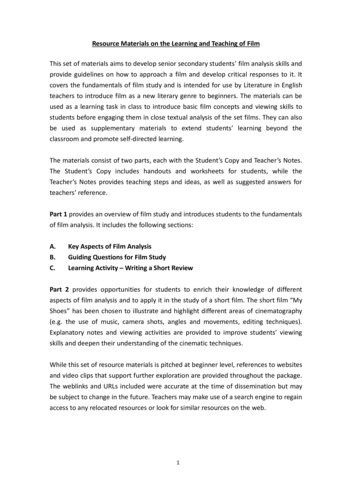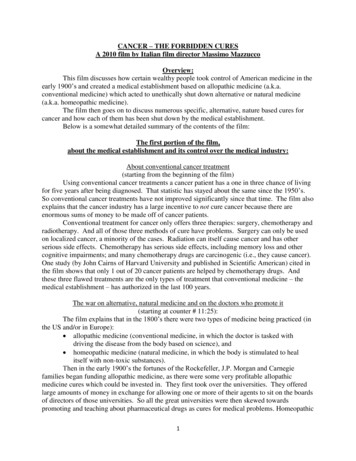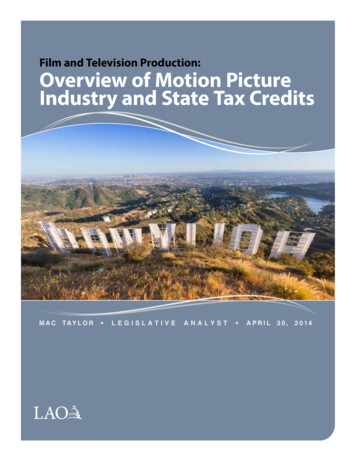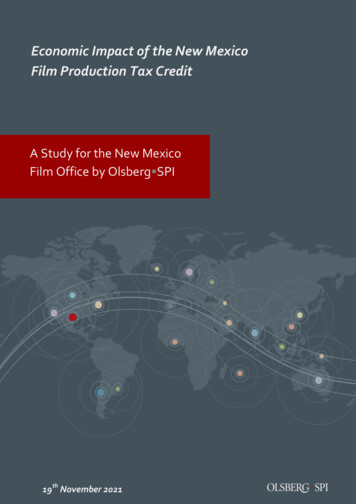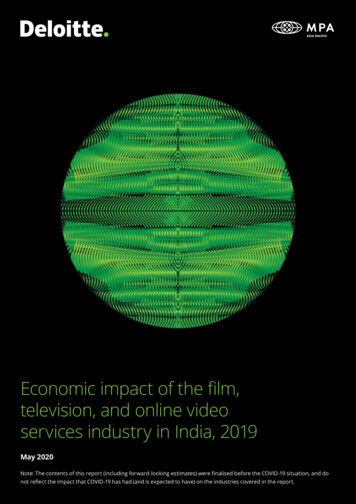
Transcription
Economic impact of the film,television, and online videoservices industry in India, 2019May 2020Note: The contents of this report (including forward-looking estimates) were finalised before the COVID-19 situation, and donot reflect the impact that COVID-19 has had (and is expected to have) on the industries covered in the report.
Economic impact of the film, television, and online video services industry in India, 2019ii
Economic impact of the film, television, and online video services industry in India, 2019Table of ContentsForeword02Executive summary03Economic impact: The multiplier effect07 Introduction: Direct, indirect, and induced impact07 Snapshot of direct, indirect, and induced impact by sector07 Multiplier effect in action09 Impact beyond the numbers13Enabling high growth: The large needle movers16 #1 Creating a culture that cherishes IP16 #2 Opting for “light touch”, stable regulations20 #3 Continuing the focus on ease of doing business20Exploring the sub-sectors22 Film22 Television42 Online video services56Appendix66 Approach to estimating direct impact66 A note on indirect impact using the input-output approach67 Snapshot of online video services offerings68Glossary71Endnotes7301
Economic impact of the film, television, and online video services industry in India, 2019ForewordIndia’s film, television, and online video services industries(together referred to as “creative industries” in this report)represent a combined revenue of about INR 93k cr (US 13.3 bn) – a little over half of the country’s total media andentertainment (M&E) industry revenue. They generate agross output of INR 115k cr (US 16.5 bn), and employ 8.5lakh (850,000) people. This is the direct impact created bythese industries. But their total impact is far more.The government and policy makers have demonstratedpositive intent in many ways, including designating theAudio - Visual Service Sector (under the M&E industry), as a"Champion Service Sector", forming effective bodies suchas the Maharashtra Cyber Digital Crime Unit (MCDCU) andpassing novel and practical rulings like the recent DelhiHigh Court judgement to tackle the problem of mirror/redirect/alphanumeric websites.In an earlier report, we discussed that the creative industriesgenerate a total impact that is disproportionate to their directimpact – the multiplier effect. Including indirect and inducedeffects, we estimate that these industries generate a grossoutput of as much as INR 349k cr (US 49.9 bn) i.e. 3 timesdirect gross output, and employ as many as 26.6 lakh(2.6 mn) people i.e. 3.1 times direct employment!However, hurdles and challenges remain. To put thecreative industries on a higher growth trajectory, thegovernment and stakeholders could consider the followingthree key recommendations.In addition to this, creative industries also create an impactin several important ways that are not captured by justthe numbers above. These industries can connect people,cut across cultural and political divides, act as a source ofidentity and expression, and shape attitudes and thoughtprocesses. They are uniquely powerful tools to aid nationalintegration, deliver social messages and project India’sculture and influence on the global stage.India has a vibrant film, television and online videoservices industry, and is brimming with potential. It isthe largest producer of movies in the world and has thelargest DTH and the second-largest pay TV subscriberbase in the world. The online video services sectoris poised for rapid growth. Smartphones with screensizes exceeding six inches are available in India forjust INR 7,000 (US 100). Connectivity is cheap, with anaverage price per GB for wireless data of INR 7.0 (US 0.1) - the lowest in the world by far! This has unlockedan insatiable appetite for data, with Indian wirelesssubscribers consuming on average 10.4 GB of dataper month. Data usage strongly correlates with videoconsumption, and the rapid increase in the number ofvideo streaming services (from 9 in 2012 to more than35 in 2019) indicates the massive potential that marketparticipants see in India.Siddharth Roy KapurPresidentProducers Guild of India021. Create a culture that respects and values intellectualproperty (IP). This could borrow core elementsfrom the powerful “Swachh Bharat Abhiyan”, whichset about creating a culture of cleanliness andresponsibility. If India wants to promote innovation,creating an environment that cherishes IP is nonnegotiable.2. Opt for “light touch” regulations, let market forces runtheir course and avoid frequent tweaks to regulations,thus enabling the industry to plan ahead rather than toreact.3. Continue the focus on ease of doing business.Enable the opening of new movie screens and help tobetter India’s under-screening problem, and focus onsimplifying processes that can ease film shooting inthe country.Now is also the opportunity to adopt the forward-thinkingideas contained within the 2016 National IPR Policy.Implementation of this policy in letter and spirit may resultin India having one of the most vibrant IP jurisdictions inthe world.Lastly, the key takeaway from our last report continuesto remain relevant. Policy makers and stakeholderscould consider the total impact created by the creativeindustries and note that growth (positive or negative) inthese sectors is expected to produce a magnified impacton the economy through the multiplier effect.Jehil ThakkarPartnerDeloitte India
Economic impact of the film, television, and online video services industry in India, 2019Note: The contents of this report (including forward-looking estimates) were finalised before the COVID-19 situation, and do not reflect the impact thatCOVID-19 has had (and is expected to have) on the industries covered in the report.Executive SummaryScale and outlook for the film, television, and OVSsectors in IndiaThe film, television, and OVS industries (together referredto as “creative industries” in this report) in India representa combined revenue of about INR 93k cr (US 13.3 bn)1 .Against the backdrop of a sluggish economy, these industrieson aggregate have been resilient and performed well.The film sector is expected to post a growth of about 20percent in FY20202 , and the OVS industry remains in stronginvestment mode. The TV industry is in transition due toregulatory changes. Even the advertising revenue in FY2020has been affected by the economic slowdown as the Indianeconomy moves towards formalisation.India’s young population and rising incomes are expectedto translate into rapid growth in discretionary spends.Unlike several developed markets, we expect traditionalvideo to continue growing in India and OVS to have anadditive (as against a disruptive) impact (at least in themedium term). In our base case, we expect the creativeindustries to grow at a CAGR of 10–11 percent overthe next 3–4 years. However, creating a supportingenvironment could put these industries on a highergrowth trajectory of 14–15 percent. This higher growthcan unlock a correspondingly larger indirect and inducedimpact on the overall economy.Economic impact of the film, TV, and OVS sectors inIndiaThe creative industries are estimated to generate adirect gross output of INR 115k cr (US 16.5 bn), andprovide direct employment to 8.5 lakh (848k) people3.Accounting for indirect and induced effects, the industryis estimated to generate a total gross output of INR 349kcr (US 49.9 bn) and a total employment of 26.6 lakh(2.6 mn) 4.We estimate that the industry could add INR 233k cr(US 33.3 bn) of total gross output and 11.1 lakh (1.1 mn)total jobs over the next five years (base case growth)5 . Ifthe creative industries follow a high growth path, theseestimates could be 40–50 percent higher.The representation shows the direct and total economic impact of the industry.Snapshot of direct and total (i.e. direct indirect induced) economic impactFY2019Gross output (INR ‘000 cr)349Combined revenue of all industry participants (may involve115an element of double counting, depending on how valuechain is broken). Includes indirect taxTotal value added (INR ‘000 cr)Value added to key factors of production – capital andlabor – in the form of Earnings before Interest Tax,depreciation and amortization (EBITDA) and wagesrespectively. Also includes indirect taxes47Employment (lacs)Jobs created as a result of industry activity8.5FY202458219229617826.67812.037.7Source: Deloitte analysisNote: The smaller icons in yellow denote the direct impact of the parameter mentioned. The larger icons in green denote the overall (direct indirect induced) impact of the same parameter.03
Economic impact of the film, television, and online video services industry in India, 2019Putting the creative industries on a high growth pathThe creative industries are expected to traverse a naturalgrowth path driven by fundamental demographics(refer to our base case growth rates below). However, asupportive environment fostered through key enablers(indicated on the right) could shift these sectors to ahigh growth trajectory (14–15 percent CAGR vis-à-vis theexpected 10–11 percent). This would translate into a 16percent higher industry size five years down the line, andalso unlock the associated direct, indirect, and inducedeconomic benefits. This high growth trajectory couldcreate additional 5–6 lakh jobs five years down the line(over and above the base-case growth trajectory).Key enablers for high growth include: Creating a culture that respects and values IP Opting for “light touch” regulations, avoiding frequenttweaks to regulations, and letting market forces run theircourse for the most part Continuing to focus on ease of doing business—notablyelements that can ease opening of new movie screens,and ones that can ease film shooting in the countryOther factors that could enable a high growth path (suchas skilling) are listed later in this report.Film, television, and OVS industry revenue in India (INR ‘000 cr/US bn)20014–15%growth caseCAGR gh 25.676.6/10.970/10200FY2019FY2020 (E)TelevisionNote: Values shown as INR ‘000 cr/US bnSource: Estimates detailed later in this report04FilmFY2024 (P)Base CaseOVSFY2024 (P)High Growth Case
Economic impact of the film, television, and online video services industry in India, 201905
Brochure sion, Sectionandtitleonlinegoes here video services industry in India, 201906
Economic impact of the film, television, and online video services industry in India, 2019Economic impact:The multiplier effectIntroduction: Direct, indirect, and induced impactThe economic impact of the creative industries ismeasured under three buckets: Direct impact: The output that is produced andemployment that is generated by companies that aredirectly engaged in the film, TV, and OVS industries Indirect impact: The output that is produced andemployment that is generated by suppliers to thecreative industries, as a result of economic activityby these creative industries. For instance, increasedactivity by the film sector will drive demand for hotels,transportation, cameras, etc., which will in turn generateeconomic output and employment. Induced impact: The output that is produced andemployment that is generated because of theconsumption triggered by the direct and indirectemployees above spending their wages.We have used the concept of input-output tables toestimate the indirect and induced impact of the film, TV,and OVS industry. This is a well-accepted tool to studythe impact of one sector on others, and on the overalleconomy.Input-output tables provide a detailed dissection ofintermediate transactions in an economy, and are thus ameans to describe the supply and use of products withinan economic system.The tables attempt to answer the question: If an industryhas to grow its output by INR 1, how much should theoutput of all the industries in the economy grow by? This isbest explained through a simplified example.Suppose the TV industry requires only two inputs toproduce an output worth INR 100, viz. INR 20 worth ofcameras and INR 10 worth of catering. Now, if the TVindustry were to increase its output by INR 10, the cameraindustry would need to increase its output by INR 2and the catering industry by INR 1. This total increasedproduction of INR 3 by suppliers to the TV industry is calledthe first-round effect.However, to increase output by INR 2, the camera industrywould, for example, require the plastic industry to raiseoutput by INR 0.2, and the lens industry to raise its outputby INR 0.3. Thus, there is a second order effect of INR0.5. Those sectors, in turn, will have backward linkagesfor their increased output. This is essentially an iterativeprocess through which the input-output table is calculated.The input-output table enables us to determine the overallimpact after full set of iterations. Similarly, they allow us toestimate the induced impact.More details about the input-output tables and ourmethodology are provided in the appendix.Snapshot of direct, indirect, and induced impact bysectorA snapshot of the direct and total impact (direct indirect induced impact) of the film, TV, and OVS industries isprovided below. The key metrics presented are as follows: Gross output: This is the combined revenue of allindustry participants. It involves an element of doublecounting, depending on how the value chain is broken. Itincludes indirect tax. Total value added: This includes the GVA, i.e., thevalue added to key factors of production— capital andlabour—in the form of EBITDA and wages, respectively.This also includes indirect taxes. Employment: This represents the jobs created becauseof industry activity.07
Brochure sion, Sectionandtitleonlinegoes here video services industry in India, 2019Snapshot of economic impact by sectorGross output (INR cr)5,074Gross output (US Direct impact1,15,354Total Impact (direct indirect/induced) 3,48,972Direct impact16,479Total Impact (direct indirect/induced)49,853Snapshot of economic impact by sectorTotal value added (US mn)Total value added (INR ,8575,63018,551Television46,748Total Impact (direct indirect/induced) 1,77,575086,007FilmTelevisionDirect Impact809-15Direct ImpactTotal Impact (direct indirect/induced)6,67825,367
Economic impact of the film, television, and online video services industry in India, 2019Snapshot of economic impact by sectorEmployment (lakhs)0.13OVS2.56FilmEmployment ('000)0.927.365.80 TelevisionDirect ct impact8.48Total Impact (direct indirect/induced) 26.62848Total Impact (direct indirect/induced) 2,662Source: Deloitte analysisNote: Additional detailed analysis by sub-sector is presented later in this reportMultiplier effect in actionSpurring demandCreative industries represent a powerful means to shapeperception and influence demand. Demand could bespurred through several mechanisms, including thefollowing: Build awareness: Create awareness and interest aboutsomething the viewer may not know about. For instance,introduction of new locations through scenes in moviesand TV series. Build familiarity: Reduce intimidation or unfamiliarityby displaying frequent usage of a product/service, or byhaving a relatable character use the product/service.For instance, positive scenes in an airport or in anaeroplane setting could make the prospect of flying lessintimidating for someone who has never flown before. Build aspiration: Create an aspirational value for aproduct/service by displaying it in a luxuriant manner,or by having an admirable character use the product/service.The power of creative industries to spur demand isexplored below through the lens of tourism, as well as abroader set of products and services.Spurring demand: Impact on tourismIn an earlier report, 29 we had discussed the impactof film shooting on tourism, and presented severalexamples. We also estimated that a medium-largebudget movie (total production budget of INR 55–60cr, excluding payment for lead actors) with box officecollections of INR 80 cr could spur an 80 percentadditional revenue from tourism, and generatetourism related employment of 37 times the size of theproduction crew. These estimates were made assumingthat the movie would increase tourist footfalls by 30percent.09
Economic impact of the film, television, and online video services industry in India, 2019Examples of impact of movies on tourismSense and Sensibility39% increase in tourism revenueBraveheart300% increase in visitors a year after releaseHeartbeatThree times the number of normal visitorsTo the Manor Born37% increase in tourism revenue between 1978 and 1980Middlemarch27% increase in tourism revenue in 1994Mrs. Brown25% increase in tourism revenuePride and Prejudice150% increase in visitorsIndonesiaEat, Pray, LoveBali was struggling due to terror attacks, and the movie helped itbounce backThailandThe Beach23% increase in tourist inflow in 2000Deliverance20,000 film tourists a year, gross revenues reached US 2-3 mnDances with Wolves75% increase in tourism revenue, vis-a-vis 7% for previous four yearsClose Encounter with the Wolves25% increase in 1975, 20% visit even today because of the filmThelma and Louise19% increase in tourism revenue in 1991Field of Dreams35,000 visits in 1991, steady increase every yearSteel Magnolias48% increase in tourism revenue a year after releaseLittle Women (1994)65% increase in tourism revenue a year after releaseBull Durham25% increase in attendance a year after releaseMiami Vice150% increase in German visitors from 1985 to 1988The Last of the Mohicans25% increase in tourism revenue a year after releaseUKUSASource: “Competitiveness of Tourism Sector in India with Selected Countries of the World” - Ministry of Tourism, Government of India10
Economic impact of the film, television, and online video services industry in India, 2019We had discussed India related examples in our earlierreport. In the table above, we have listed severalinternational examples of the impact of movies ontourism, which lend further credence to the role ofshooting and movies on tourism. These examplesmake a case for encouraging film shooting in India. Theinclusion of both the audio-video and tourism sectors inthe “Champion Service Sector” umbrella is an indicatorthat the government is cognizant of this impact, andshows the positive intent of the government. Creationof such incentives, as well as timely disbursement offunds earmarked under these initiatives are expected toencourage participation by industry, and lead to realisingthe benefits of film shooting.Creative industries offer a platform to drive demand fora variety of products and services. Examples of creativeindustries driving demand for products/services (varyingfrom sunglasses to recruitment for defence forces) arediscussed in the table below.Some of the fims shaping choices across the yearsFilmProduct/serviceCommentImpactRisky Business(1983)Wayfarer sunglasses A popular comedy that(Ray Ban)launched lead Tom Cruise’scareer. His character woreWayfarers in themovie.E.T. the ExtraTerrestrial (1982)Reese’s pieces(Hershey)Frequently making it toJack Dowd, then Director, New Products“greatest film of all time” list,Development, recalled that the resultingE.T. became the highestsales far exceeded expectations.30 Accordinggrossing film of all time when it to a 1983 People magazine article, Hershey’sreleased (surpassing Star Wars), profits rose 65% because of E.T.and held the record for11 years. In the movie, the alienE.T. is lured into the house by atrail of Reese’s pieces.The Italian Job(2003)Mini Cooper car(BMW)This heist movie was onlymoderately successful.However, more than 30 carsthat BMW provided for theproduction were prominentlyfeatured.Top Gun (1986)Aviator sunglasses(Ray Ban)Two years prior to the movie, Ray Bansold just 18k pairs of Wayfarers and wascontemplating to discontinue the product.Ray Ban’s product placement firm got thesunglasses into 60 films and TV shows overthe next five years, including Risky Business.By 1986, Ray Ban sold 1.5 mn Wayfarers(360k coming in the year Risky Business wasreleased).BusinessWeek reported that since the film’s2003 release, the car experienced a 22%increase in sales over the previous year.This popular film featuringThe film is estimated to have boosted Aviatordazzling aerial footage starred sales by 40%.Tom Cruise as a US Navy pilotUS Navy recruitmentThe US Navy also experienced a notablewho wore Aviators.increase in pilot applications.11
Economic impact of the film, television, and online video services industry in India, 2019FilmProduct/serviceCommentGoldeneye (1995)Z3 car (BMW)This James Bond film featured BMW received 9,000 orders for the Z3 theBMW’s Z3 instead of an Aston month after the film opened.Martin model, which wasused in the preceding 16 Bondmovies. This Z3’s appearancewas the first in a three-picturedeal that BMW had made.Transformers(2007)Modified ChevroletCamaroTransformers:Revenge of theFallen (2009)The Transformers series depicta war between two alien racesof robots, the Autobots andCar (General Motors)the Decepticons, and bothcan change into cars. GeneralMotors contributed a modifiedChevrolet Camaro to theproduction.ImpactThe modified Camaro did not exist in themarket, and the series created a demand forthe car. General Motors brought the modifiedcar to the market in 2009 and sold 60,000units by the end of the year.Lost in Translation Suntory whisky(2003)This critically acclaimedcomedy-drama featured BillMurray as an aging screenlegend who visits Tokyo to filma commercial forSuntory Whisky.Masaki Morimoto, General Manager forSuntory’s premium-spirits marketingdepartment, was quoted as saying, “It was agreat boost for us. Our company got famousinternationally.”The Firm (1993)Red Stripe beerThis film based on JohnGrisham’s thriller novel has ascene where the protagonistand his mentor drink RedStripe beer and the productis prominently displayed andnamed.According to Business Week, sales of theJamaican beer increased by more than 50%in the US. Just a few weeks after that, thecompany’s owners sold a majority stakein their brewery to Guinness BrewingWorldwide for US 62 mn.Sideways (2004)Pinot noir wine(particularlyBlackstone)This unexpected hit about twomen in the wine country ofCalifornia featured scenesof wine tasting sessions.Sales of pinot noir increased in the US inthe months following the film’s release. Inparticular, the Blackstone brand’s sales roseby 150%.Merlot wineThe film’s main character is vocal in hisdistaste for merlot. Following the film’srelease, US sales of merlot dropped by 2%.Source: CNBC article on “10 Big Successes in Product Placement”12
Economic impact of the film, television, and online video services industry in India, 2019Case study: Amazon Prime Video—a hattip to the multiplier effect?Amazon offers a varied spectrum of productsand services. There is a popular book aboutthe company titled “The Everything Store”.Some industry watchers believe that Amazonmay look to take a cut of all economicactivity. Amazon’s popular membershipprogramme “Amazon Prime,” which has over150 mn members, 31 is an important partof the company’s strategy. According to astudy by Consumer Intelligence ResearchPartners, Prime members spend 2.3 timesas much as regular customers on Amazon. 32There are two key benefits for Primemembers that Amazon specifically callsout in its U.S. SEC 10-K filings. 33 The first isunlimited free shipping on more than 100mn items. The second is access to unlimitedImpact beyond the numbers“You can’t manage what you can’t measure.”Apocryphally attributed to management guru PeterDrucker, this phrase captures the essence of ourtendency to focus on quantification and measurementacross fields—be it sports, medicine, or public policy.This proclivity to quantify everything makes ussusceptible to the “streetlight effect”. We may behavea bit like a drunk who has lost his key in the dark, butis looking for it on the other side of the street under alamppost—because that’s where the light is.Our natural desire to focus where the light is brightest,where data is available, and where things can bequantified, may cause us to miss the most importantissues that need to be taken into account. 35Creative industries can connect people, bridge cultural andpolitical divides, act as a source of identity and expression,and shape attitudes and thought processes. These arestreaming of thousands of movies and TVepisodes, including Amazon original content(collectively called “Amazon Prime Video”).Amazon spent US 7.8 bn on video and musiccontent in the year ended 31 December 2019(US 6.7 bn the previous year). 34One could argue that the level of attentionand spend on creative content by Amazon— a company which could be likened toa mini-economy — indicates that suchcontent produces an indirect impactgreater than what might be apparent onthe surface. In conclusion, one could saythat a large part of the business casefor Amazon Prime Video derives fromthe multiplier effect it produces on the“Amazon economy”.some areas where the impact of creative industries cannotbe measured in numbers. Some examples of the impactof creative industries beyond the numbers are discussedbelow. National Integration: India is a diverse country, with22 official languages and several rich and variedsub-cultures. The output of creative industries cantranscend cultural differences, offering a powerfulmeans to enhance “unity in diversity” and nationalintegration. Consider the movie "Mission Mangal",which was about India’s Mars Orbiter Mission. Thismovie celebrated India’s incredible success in puttingan orbiter around Mars in its first attempt (the onlycountry to achieve this feat) and at a cost of underUS 75 mn. 36 The movie resonated with audiencesacross the country and fostered a sense of pride inthe nation. It also sparked interest in astronomy andraised awareness about ISRO and its "Chandrayaan 2"lunar mission.13
Economic impact of the film, television, and online video services industry in India, 2019 Social messages: Creative industries offer a means todeliver messages that stick. As India rises from a lowto a middle-income economy, video offers an option totransmit important social messages around topics, suchas health and nutrition, cleanliness, and environmentto its population (25 percent of which is not literate).37The power of creative industries to shape culture andbehaviour can be used to generate positive socialoutcomes for the country. For instance, the movie"Padman" addressed the sensitive topic of menstrualhygiene through its real-life story of social entrepreneurArunachalam Muruganantham. Several recent filmshave explored other sensitive issues, such as infertility("Vicky Donor", "Shubh Mangal Saavdhan"), andpremature balding ("Bala"). These movies have laced thesensitive topics with light humour, making the messagesmore palatable and memorable whilst also enjoyingcommercial success. Spreading culture and influence (soft power): Contentgenerated by creative industries is one of the keywindows through which the world views and developsa perception about a country. Creative industries thus,represent a compelling vehicle to expand a country’sinfluence. With online video services making distributionlargely frictionless, creative output can instantly reach aworld-wide audience. India could use creative industriesto showcase Indian products (such as khadi or yoga).Soft power could also be realised in other ways. Chinarapidly expanded movie screens, adding an average of 19new screens per day from 2012 to become the countrywith the highest number of screens (surpassing the US)in 2017, with 45,000 screens.38 By the end of 2018, Chinawas estimated to have 60,079 screens. Today, China isthe second-largest movie market in the world.39 Thereis a subtle incentive for Hollywood and other foreignfilms to portray China in a positive light—the desire to besuccessful in the large Chinese market.The government needs to harness the cultural impact the Industry has, forvalue creation in the economy.Rahul PuriManaging Director, Mukta Arts Limited14
Economic impact of the film, television, and online video services industry in India, 2019Enabling high growth:The large needle moversOur discussions with industry participants have surfacedchallenges and obstacles to growth. While there is a longlist in a later section of this report, we discuss here threekey factors that could have a large role to play in creating ahigh-growth environment.The government and policy makers have already shownsupport for the industry and demonstrated their positiveintent in many ways. Some of these include the following: Designating the Audio - Visual Service Sector (under theM&E industry) as a “Champion Service Sector” Forming effective bodies, such as the MCDCU The High Court of Delhi’s recent (novel and practical)ruling on dynamic injunction to tackle the problemof mirror/redirect/alphanumeric websites in a bettermannerthrough mantras such as IPPP – Innovate, Patent, Produce,and Prosper.8 He has also expressed his desire to see Indiawithin the top 25 in the Global Innovation Index (Indiacurrently ranks 57, up from position 81 in 2014).9,10 India’splanning think-tank NITI Aayog recently released an IndiaInnovative Index (III) to create synergies between differentstakeholders in the innovation ecosystem.11Addressing the three factors listed in this se
Economic impact of the film, television, and online video services industry in India, 2019 03 Scale and outlook for the film, television, and OVS sectors in India The film, television, and OVS industries (together referred to as “creative industries” in this report) in India represe


